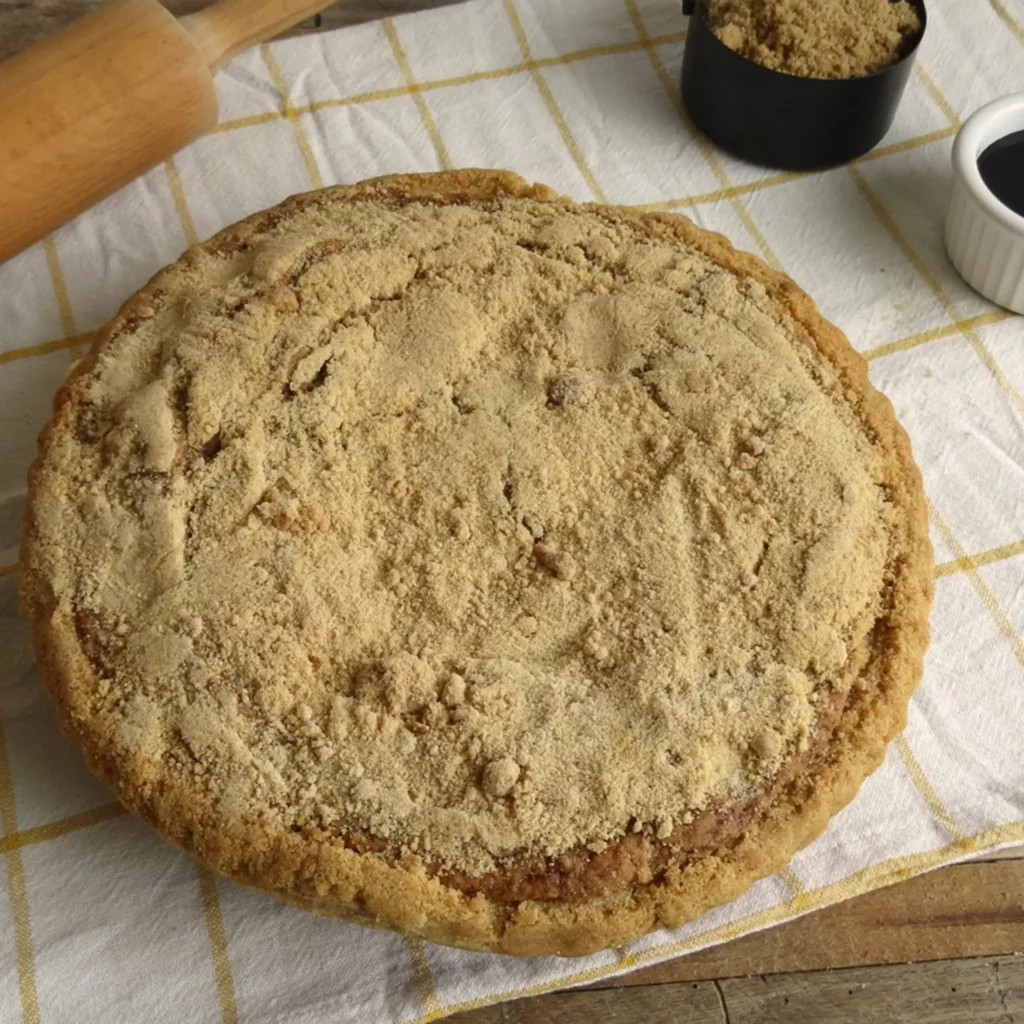If you’ve ever visited Central Pennsylvania bakery, you’ve probably come across a pie with a dark brown filling described as either “wet-bottom” or “dry-bottom.” Both the descriptors and name of Shoofly pie could be a turn-off to some, but the sweet, sticky treat is a beloved dessert in the area.
Ethan and Holly and digging in (literally and figuratively) to Shoofly pie in this episode. They’ll discuss its history, variations, and more.
Listen here or anywhere you get your podcasts: https://podcasts.apple.com/us/podcast/pennsylvania-life-legends-and-lore/id1673471716
Follow Pennsylvania Life, Legends, and Lore wherever you get your podcasts to stay up to date on new content!
What is Shoofly Pie?
Shoofly pie is a type of sweet molasses crumb pie associated with Pennsylvania Dutch cuisine. With its rich flavor, gooey syrup, brown sugar, and crumb topping, this delicious treat has been a longtime staple in Central PA, and a must-try for all pie enthusiasts.
What is in Shoofly Pie?
The star of the show is molasses, but Shoofly pie is also typically composed of flour, brown sugar, water, spices, and sometimes egg. The pie is topped with a crumb mixture and served in a flaky pie crust. Shoofly pie is like a coffee cake but with a gooey molasses bottom.
The History:
Usually consisting of a basic piecrust with a cake-like molasses-flavored filling and a crumbled flour, sugar, and butter topping, this humble pie has a convoluted history. Though closely associated with the Pennsylvania Dutch community, Shoofly pie’s popularity has extended well beyond the farm since its first official appearance in the late 1800s. While Shoofly pie has been a staple of Moravian, Mennonite and Amish cuisine, there isn’t a lot of concrete information about its origins, and most of the legends concerning the pie are myths, including the persistent belief that the name comes from flies being attracted to the sweet filling.
The first sizeable group of Amish immigrants arrived in America around 1730, from Germany and Switzerland, and settled near Lancaster County, Pennsylvania. Pies of all types were integral to the culture of these settlers, and they ate them at any time of day. The most famous of their pies is the Shoofly pie, which originated as a variation of a treacle tart.
Treacle is the British generic name for any syrup made during the refining of sugar cane. During the 17th century, treacle was used chiefly as a cheap form of sweetener. By the late 1700s, refined sugar became affordable to the masses in Britain and overtook treacle as a general sweetener. However, molasses was often substituted for treacle in colonial American recipes. Many early cookbooks have molasses pie and cake recipes.
As these very earliest settlers came to North America by boat, they brought with them the staples of their diet – long-lasting non-perishables that would survive a long boat trip – flour, brown sugar, molasses, lard, salt, and spices. Arriving in the new land during late fall, the settlers had to live mostly on what they had brought with them until the next growing season. Women in these communities were masters of the art of “making do,” and concocted a pie from the limited selection that could be found. This resourcefulness led to the creation of Shoofly pie.
Since this original version called for pantry essentials like butter, flour, sugar, cinnamon, nutmeg, coffee, and molasses, Shoofly pie was inherently inexpensive to make, which made it popular among home bakers. Due to the absence of eggs and the time-frame in which settlers arrived in the Central PA region, historians conclude Shoofly pie was originally a winter dish. Hens generally lay fewer eggs in the colder weather and molasses could be stored in the cold weather without fear of it fermenting. A pie without eggs produces a longer shelf life.
Instead of eggs, baking powder was used to leaven the pie. The use of baking powder places its invention firmly after the Civil War and in the 1870s, when the Pennsylvania Dutch began using baking powder. The addition of eggs was made in the 1920s.
According to historian William Woys Weaver, director of the Keystone Center for the Study of Regional Foods and Food Tourism, Shoofly pie was first introduced as a coffee cake in 1876 at the U.S. Centennial in Philadelphia, Pennsylvania to celebrate the 100th anniversary of the signing of the Declaration of Independence. There actually existed a saying “Shoofly pie on the Fourth of July.”
Weaver affirms that between 1876 and the early 1880s, the Shoofly cake migrated to a pie shell because it was easier to eat as a hand-held slice of pie- without a plate or fork- so it appealed to farmhouse cooks.
As the popularity of the pie grew due to its taste and simplicity, Shoofly pie gradually became a regularly stocked dish in Central PA households. Customarily, it was served up only for breakfast or in the evening with supper, or as a field break snack with coffee. Though it is now often eaten as dessert, this hearty treat in some areas of Pennsylvania still is a breakfast staple, dipped in a mug of coffee and usually eaten by hand.
Variations:
There are two heavily debated variations of the pie: dry bottom and wet bottom. Using flaky or mealy crust for the pie dough determines whether the bottom of the pie is thick or barely there.
Recipes differentiating between wet and dry versions appeared in the early 20th century; the dry version was suitable for dunking in a cup of coffee.
Some cooks put chocolate icing on top for a chocolate Shoofly pie. Some use spices – some do not.
What is a Dry Bottom Shoofly Pie?
The dry bottom version resembles a soft gingerbread or dry cake-like texture. Baked until fully set, the dry bottom is considered the original version, producing a consistency that is meant for dipping in coffee.
What is a Wet Bottom Shoofly Pie?
A wet bottom Shoofly pie features a tender molasses custard topped with crumbs and the bottom is a stickier, gooier custard-like consistency. More prevalent in the Pennsylvania Dutch region, this version came about in the 1920s by accident. “A pie didn’t get cooked enough, and some people discovered they liked it that way,” William Woys Weaver says.
Though both versions are traditionally flavored with molasses, the wet version has a stronger taste of the dark syrup. Wet bottom pie is similar in texture to a pecan pie, just without the pecans. But that bitter, almost harsh flavor of the molasses can really turn some people off. In the dry bottom version, the molasses ribbons through layers of cake, so it’s a little easier on the palate.
In some bakeries that cater to tourists, this key ingredient of Shoofly pie is often toned down or replaced altogether with milder, sweeter corn syrup. However, just as many Pennsylvania Dutch bakeries would shudder at the thought of replacing the flavorful syrup. Which one you get all depends on where you go.
Dry bottom, wet bottom, bitter, sweet—like any recipe that’s been around for over a century, there are as many variations of Shoofly pie as there are bakers in Central PA, giving this delicious oddity the mark of a true classic.
Everyone agrees the Shoofly pie is best when slightly warmed and with whipped cream on top. If you like sweet desserts, you will probably love Shoofly pie!
What does Shoofly pie taste like?
The batter’s combination of molasses and spices creates an almost chocolate-like taste. The final product yields an intense sweetness and cake-like texture.
While you can refrigerate your Shoofly pie, it doesn’t need to be refrigerated. Shoofly pie will keep covered on the countertop for a few days at room temperature. One alternative is to freeze your Shoofly pie if you don’t plan to eat it right away. To defrost, place the pie in tin foil and thaw it at room temperature.
How did Shoofly pie get its name?
The unusual name is presumed to be a reference to the fact that the sticky, sweet pie is so attractive to flies that they have to be constantly shooed away from it.
However, this is a myth that originated with author Patricia Brunning Stevens. According to Stevens, the unusual name of Shoofly pie came from “the fact that pools of sweet, sticky molasses sometimes formed on the surface of the pie while it was cooling, inevitably attracting flies.” She suggests the pie’s invention stems from Pennsylvania Dutch farm wives making do with what remained in the pantry during the late winter. However, she fails to answer the question of where all the flies came from in the winter season.
Historian William Woys Weaver, who is also a 13th-generation Pennsylvania Dutchman, states the name “Shoofly” was derived from Shoofly the Boxing Mule. Shoofly was a popular traveling circus animal in southeastern Pennsylvania at the time, and his name originated from a popular song at the time, “Shoo, Fly, Don’t Bother Me!”
The animal was trained to stand on his hind legs and wore boxing gloves on his front hooves. His frequent opponent was a horse. Shoofly was so beloved they named products in his honor including Shoofly Flour, Shoofly Horse Powder, and a very popular brand of molasses from Philadelphia – Shoofly Molasses.
Another theory is that because it originated as a Pennsylvania-Dutch specialty, it is possible that Shoofly is an alteration of an unidentified German word. Shoo-fly pie was called Melassich Riwwelboi or Melassichriwwelkuche (molasses crumb cake) in the Pennsylvania Dutch language. Before its modern name became popular during the 20th century, it was molasses crumb pie or soda rivel cake (rivels are lumps of food).
According to The Encyclopedia of American Food & Drink, by John Mariani (p. 293) the name Shoofly pie was used in the 1880s, but its first appearance was not recorded in print until 1926. The pie is also mentioned in the song “Shoo-Fly Pie and Apple Pan Dowdy,” popularized by Dinah Shore in the 1940s.
Where to find shoofly pie
Throughout most of American restaurants and bakeries, you’ll rarely find Shoofly pie. But most Central Pennsylvanian bakeries and restaurants sell this regional favorite. In Amish country, this pie draws standing-room-only crowds. Bird-in-Hand is famous for Grandma Smucker’s Shoofly pie. The bakery prepares the Shoofly pie from an old family recipe handed down for generations and fine-tuned by Grandma Smucker. It is one of Bird-in-Hand Bakery & Cafe’s most popular items and can be enjoyed with a hot cup of coffee or tea. You can also order Grandma Smucker’s classic treat online to stash in your freezer or share it with a friend.

